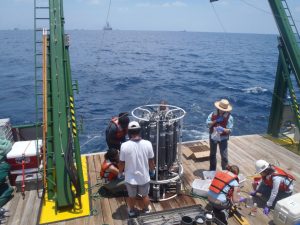Study Quantifies Deep Ocean Degradation Rates for Individual Crude Oil Compounds
– JANUARY 31, 2018
Scientists analyzed in situ deep-depth water column measurements before and after the Deepwater Horizon well was capped and calculated degradation rate estimates for 49 hydrocarbons (23% of released spill material) and inferred the rates of an additional 5 hydrocarbons. The half-lives of the hydrocarbons ranged from 0.4 to 36.5 days, and the results suggest that microbial biodegradation was the primary degradation process in the deep ocean. These biodegradation rates can help improve oil fate and transport prediction models in the event of future deep-ocean spills. The researchers published their findings in Marine Pollution Bulletin: Calculating in situ degradation rates of hydrocarbon compounds in deep waters of the Gulf of Mexico.
Understanding how different hydrocarbons degrade in the ocean is important for predicting where the oil will go and how long it will last in the environment. However, deep ocean conditions (such as cold temperatures and high pressure) make it difficult to characterize hydrocarbon weathering there. The approach that researchers in this study used circumvents the difficulty of conducting laboratory experiments under extreme conditions to find or select microbial assemblages that perform hydrocarbon biodegradation and are representative of natural deep-sea biota. Study author Anne Thessen said, “We were able to combine many different data sets to get a ‘big picture’ look at how long individual chemicals lasted in the Gulf of Mexico.”
The researchers used water column measurements from the Deepwater Horizon Database, limiting their analysis to data collected below 700 m (where water temperature remained below 7°C) and only for hydrocarbons detected in the fluid exiting the wellhead. The team summed the concentrations of large alkanes (C-35 to C-40) measured at the same location and time to get a single concentration for that group, matched individual analyte concentrations to the nearest stable analyte, and applied an exponential decay curve to determine degradation rates.
The fastest degrading analytes were toluene, methylcyclohexane, benzene, and C1-naphthalene. The slowest degrading analytes were the large alkanes (C-26 and -27). The C-18 to phytane ratio decreased to zero within three days, indicating that microbial biodegradation was a significant degradation process in water >700 m depth (a constant ratio would have indicated physical weathering). Alkane biodegradation was inversely proportional to carbon number, and 2- and 3- ring hydrocarbon degradation decreased with increasing number of rings, consistent with previous studies.
The authors noted that, even though there were an enormous number of hydrocarbon measurements before and after the Deepwater Horizon incident, more precisely timed data collections could have enhanced the study. They suggested that future response efforts could implement targeted sampling just before and after capping a well to generate more robust estimates of degradation.
“Even though millions of data points were collected as part of the spill response, we didn’t have all the information we needed to calculate degradation rates for all of the chemicals found in crude oil,” remarked Thessen. “In the event of a future spill, our research suggests that data could be strategically collected to learn more about the degradation of hydrocarbons in the environment.”
Data are publicly available through the Gulf of Mexico Research Initiative Information & Data Cooperative (GRIIDC) at doi:10.7266/N7GX48MZ.
The study’s authors are Anne E. Thessen and Elizabeth W. North.
************
This research was made possible in part by a grant from the Gulf of Mexico Research Initiative (GoMRI) to the Gulf of Mexico Integrated Spill Response Consortium (GISR).
The Gulf of Mexico Research Initiative (GoMRI) is a 10-year independent research program established to study the effect, and the potential associated impact, of hydrocarbon releases on the environment and public health, as well as to develop improved spill mitigation, oil detection, characterization and remediation technologies. An independent and academic 20-member Research Board makes the funding and research direction decisions to ensure the intellectual quality, effectiveness and academic independence of the GoMRI research. All research data, findings and publications will be made publicly available. The program was established through a $500 million financial commitment from BP. For more information, visit https://gulfresearchinitiative.org/.
© Copyright 2010-2018 Gulf of Mexico Research Initiative (GoMRI) – All Rights Reserved. Redistribution is encouraged with acknowledgement to the Gulf of Mexico Research Initiative (GoMRI). Please credit images and/or videos as done in each article. Questions? Contact web-content editor Nilde “Maggie” Dannreuther, Northern Gulf Institute, Mississippi State University (maggied@ngi.msstate.edu).






